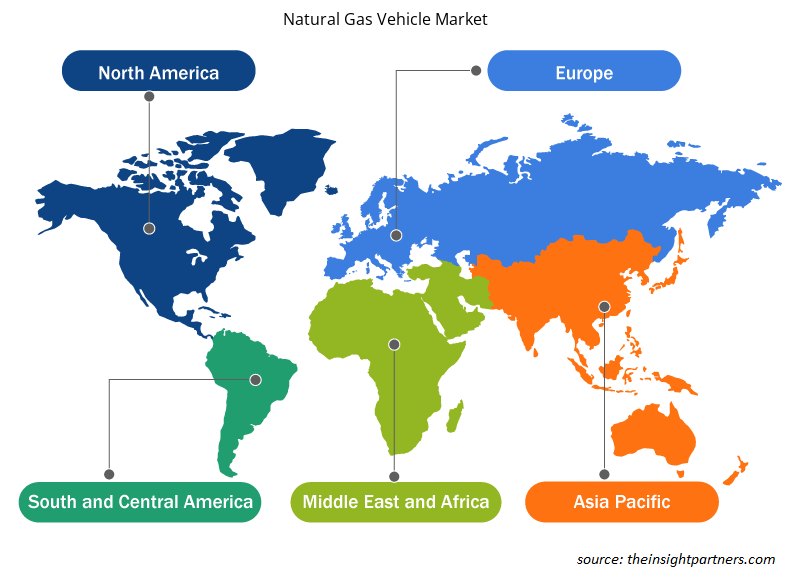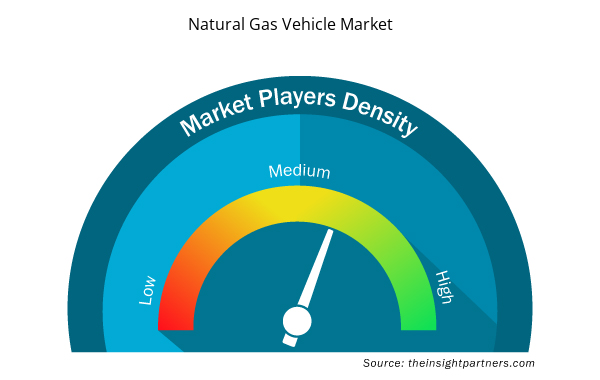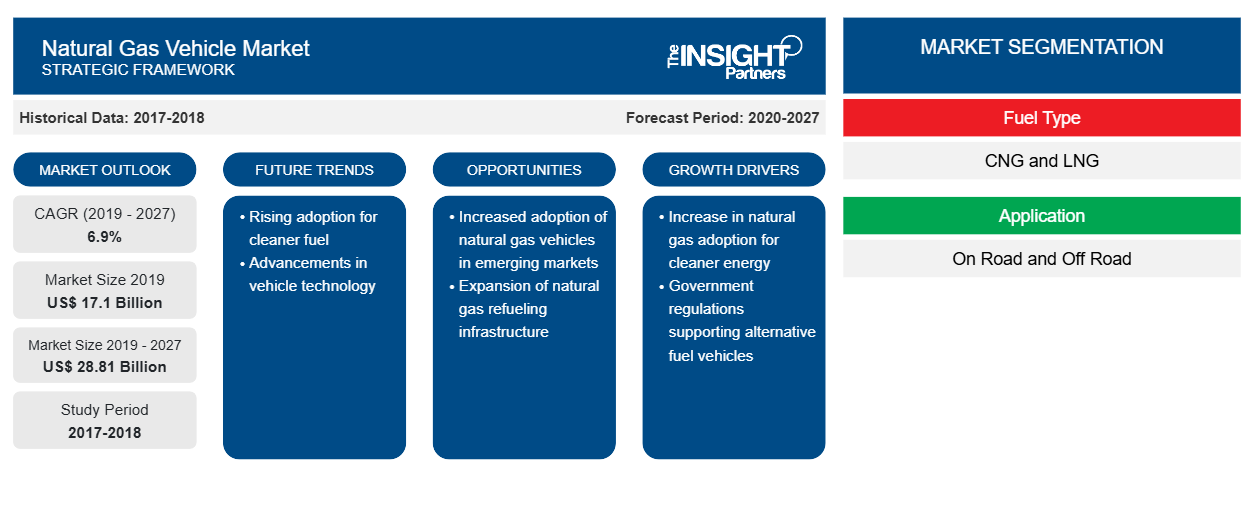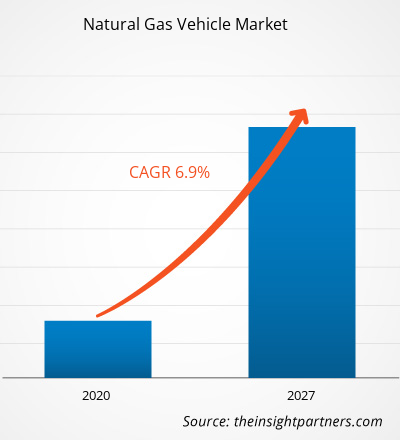بلغت قيمة سوق المركبات التي تعمل بالغاز الطبيعي 17,100.00 مليون دولار أمريكي في عام 2019، ومن المتوقع أن تصل إلى 28,805.75 مليون دولار أمريكي بحلول عام 2027؛ ومن المتوقع أن تنمو بمعدل نمو سنوي مركب قدره 6.9٪ خلال الفترة 2020-2027.
تعمل محركات المركبات التي تعمل بالغاز الطبيعي بشكل مشابه لمحركات المركبات التي تعمل بالبنزين والتي تعمل عادةً بمحركات احتراق داخلي يتم إشعالها بالشرارة. يتم تخزين الغاز الطبيعي في أسطوانة أو خزان وقود، وعادةً ما يكون مدمجًا في الجزء الخلفي من المركبة. توفر البطاريات الكهرباء لتشغيل المحرك والإلكترونيات القوية في هذه المركبات. تتحكم وحدة التحكم الإلكترونية (ECM) في توقيت الإشعال وخليط الوقود ونظام الانبعاثات؛ كما تراقب تشغيل المركبة وتكتشف المشاكل. الغاز الطبيعي هو وقود صديق للبيئة لأنه يساهم بشكل أقل في التلوث من البنزين أو الديزل وموارده متوفرة على نطاق واسع في جميع أنحاء العالم. علاوة على ذلك، تشمل الفوائد المحتملة لاستخدام مركبات الغاز الطبيعي انخفاض انبعاثات الغازات المسببة للانحباس الحراري العالمي، وخفض التكاليف، والحد من الضوضاء، وتحسين جودة الهواء المحلي. وفقًا لمركز وشبكة تكنولوجيا المناخ (CTCN)، يتم استخدام الغاز الطبيعي المضغوط (CNG) على نطاق واسع كوقود للمركبات في العالم. ذكرت CTCN أن هناك حوالي 10 ملايين مركبة تعمل بالغاز الطبيعي وحوالي 15000 محطة للتزود بالوقود بالغاز الطبيعي المضغوط في حوالي 75 دولة. في البلدان التي لديها احتياطيات كبيرة من الغاز واحتياطيات محدودة من النفط، يمكن أن يؤدي استخدام الغاز الطبيعي في النقل إلى تقليل الاعتماد على واردات النفط المكلفة. تعد سوق المركبات العاملة بالغاز الطبيعي العالمية حاليًا سوقًا متخصصة حيث أن حصة الغاز الطبيعي الحالية في النقل البري صغيرة في عدد قليل من البلدان. الدول البارزة التي تستخدم الغاز الطبيعي المضغوط في المركبات هي باكستان والأرجنتين وإيران والبرازيل.
وقد تكون هناك حاجة إلى استثمارات ضخمة في المركبات وزيادة الدعم الحكومي لإنشاء سوق المركبات العاملة بالغاز الطبيعي، حيث من غير المرجح أن تحقق العديد من البلدان أسواق المركبات العاملة بالغاز الطبيعي بمستويات انتشار أقل. وتشهد صناعة السيارات ازدهاراً في مختلف أنحاء العالم، مع زيادة سريعة في إنتاج سيارات الركاب والمركبات التجارية. وعلاوة على ذلك، فإن توسيع فوائد الغاز الطبيعي لتشمل مجموعة أوسع من الصناعات، بالإضافة إلى صناعة السيارات، من شأنه أن يجذب المزيد من الاستثمارات في شبكات النقل والتوزيع لإمدادات الغاز الطبيعي.
قم بتخصيص هذا التقرير ليناسب متطلباتك
ستحصل على تخصيص لأي تقرير - مجانًا - بما في ذلك أجزاء من هذا التقرير، أو تحليل على مستوى الدولة، وحزمة بيانات Excel، بالإضافة إلى الاستفادة من العروض والخصومات الرائعة للشركات الناشئة والجامعات
- احصل على أهم اتجاهات السوق الرئيسية لهذا التقرير.ستتضمن هذه العينة المجانية تحليلاً للبيانات، بدءًا من اتجاهات السوق وحتى التقديرات والتوقعات.
تأثير جائحة كوفيد-19 على سوق المركبات العاملة بالغاز الطبيعي
تعتمد صناعة تصنيع السيارات والنقل بشكل كبير على العمالة اليدوية. ونظرًا لقواعد الإغلاق الصارمة التي فرضتها غالبية البلدان في جميع أنحاء العالم، تشهد الصناعة عددًا أقل بكثير من العمال في مرافق التصنيع المعنية. هذا العامل يعيق صناعة السيارات والنقل، وبالتالي يقيد نمو سوق المركبات التي تعمل بالغاز الطبيعي. تعد الولايات المتحدة سوقًا بارزة لمركبات الغاز الطبيعي بسبب الدعم الحكومي المتزايد لبناء البنية التحتية لها. يؤثر العدد المتزايد بسرعة من حالات الإصابة المؤكدة بفيروس كوفيد-19 والوفيات المبلغ عنها في البلاد سلبًا على صناعة السيارات والنقل. تعمل عمليات إغلاق المصانع والشركات في جميع أنحاء الولايات المتحدة وكندا والمكسيك على تقييد الطلب على المركبات التي تعمل بالغاز الطبيعي. تضم أمريكا الشمالية عددًا كبيرًا من شركات التصنيع والسيارات؛ وبالتالي، فإن تأثير تفشي فيروس كوفيد-19 شديد للغاية على السوق في أمريكا الشمالية، ومن المرجح أن يستمر في عام 2021.
رؤى السوق - سوق المركبات العاملة بالغاز الطبيعي
زيادة التركيز الحكومي على تعزيز أمن الطاقة
إن أمن الطاقة يعني التوافر المستمر لمصادر الطاقة الفعالة من حيث التكلفة. ويتميز هذا الأمن بالعديد من الخصائص، مثل أمن الطاقة على المدى الطويل، والذي يتعامل بشكل رئيسي مع الاستثمارات في الوقت المناسب لتوفير الطاقة بما يتماشى مع الاحتياجات البيئية والتطورات الاقتصادية. ويدور أمن الطاقة على المدى القصير حول قدرة أنظمة الطاقة على الاستجابة بسرعة للتغيرات غير المتوقعة في توازن العرض والطلب. وقد شجعت حكومة باكستان على إدخال وتطوير تطبيقات الغاز الطبيعي المضغوط في صناعة النقل من خلال تدابير سياسية مختلفة. وهناك عدد هائل من المركبات العاملة بالغاز الطبيعي (حوالي 2 مليون مركبة) تسير على الطرق في باكستان، وتستهلك 2.5 مليار متر مكعب من الغاز الطبيعي كل عام. وقد أدخلت بلدان آسيوية مختلفة، وخاصة الهند، إصلاحات حاسمة لتسعير الطاقة في مجالات النفط والغاز والفحم والكهرباء، والتي تعد ضرورية لمزيد من فتح سوق الطاقة وتعزيز صحتها المالية. وقد اتخذت الهند خطوات كبيرة لتطوير أمن الطاقة لديها من خلال تعزيز الإنتاج المحلي من المركبات العاملة بالغاز الطبيعي. ومع تزايد المخاوف بشأن التأثيرات البيئية لاستخدام الوقود الأحفوري وفوائد شبكات الطاقة، يتبنى المهندسون بشكل تدريجي حلول تخزين الطاقة، وبالتالي دفع نمو صناعة أمن الطاقة. إن اعتماد الغاز الطبيعي كوقود للنقل بهدف خفض الانبعاثات الكربونية يساعد في تحقيق أهداف التنمية المستدامة مع معالجة أمن الطاقة في جميع أنحاء العالم. وبالتالي، فإن زيادة التركيز من جانب الحكومات على تعزيز أمن الطاقة تعمل على تعزيز نمو سوق المركبات التي تعمل بالغاز الطبيعي.
رؤى تعتمد على نوع الوقود
بناءً على نوع الوقود، ينقسم سوق المركبات العاملة بالغاز الطبيعي إلى مركبات تعمل بالغاز الطبيعي المضغوط ومركبات تعمل بالغاز الطبيعي المسال. ويستمر سوق المركبات العاملة بالغاز الطبيعي المضغوط في رؤية فرص مربحة بسبب العدد المتزايد من المركبات العاملة بالغاز الطبيعي والتفضيل المتزايد لمركبات الغاز الطبيعي المضغوط في جميع أنحاء العالم. علاوة على ذلك، يؤثر نمو صناعة السيارات على اعتماد المركبات العاملة بالغاز الطبيعي المضغوط.
رؤى مبنية على التطبيق
بناءً على التطبيق، ينقسم سوق المركبات التي تعمل بالغاز الطبيعي إلى مركبات على الطرق ومركبات خارج الطرق. في عام 2019، قاد قطاع المركبات على الطرق السوق. يستخدم الغاز الطبيعي في المقام الأول لتوليد الكهرباء والتطبيقات السكنية والتجارية والصناعية. يتم استخدامه كوقود للمركبات على الطرق، وخاصة في المركبات المتوسطة أو الثقيلة في الأساطيل التي تعمل بالوقود المركزي. كما تم اقتراحه أيضًا لاستخدامه بشكل أكثر سخاءً كوقود للمركبات على الطرق، وخاصة في المركبات الخفيفة.
رؤى تعتمد على نوع السيارة
بناءً على نوع السيارة، يتم تقسيم سوق المركبات التي تعمل بالغاز الطبيعي إلى مركبات ركاب ومركبات خفيفة وتجارية ومركبات تجارية ثقيلة. في عام 2019، قاد قطاع مركبات الركاب السوق. تعد سيارات الركاب القطاع الرائد في سوق المركبات التي تعمل بالغاز الطبيعي المضغوط والغاز البترولي المسال في الهند. تركز شركات صناعة السيارات الكبرى في الهند على تطوير مركبات الغاز الطبيعي أكثر من المركبات الكهربائية. يتزايد الطلب على مركبات الركاب بسبب ارتفاع دخل الفرد والحاجة إلى الرفاهية. من شأن القبول العام والدعم الحكومي القوي لمركبات الركاب التي تعمل بالغاز الطبيعي أن يدفع نمو سوق مركبات الغاز الطبيعي.
رؤى إقليمية حول سوق المركبات العاملة بالغاز الطبيعي
لقد قام المحللون في Insight Partners بشرح الاتجاهات والعوامل الإقليمية المؤثرة على سوق المركبات العاملة بالغاز الطبيعي طوال فترة التوقعات بشكل شامل. يناقش هذا القسم أيضًا قطاعات سوق المركبات العاملة بالغاز الطبيعي والجغرافيا في جميع أنحاء أمريكا الشمالية وأوروبا ومنطقة آسيا والمحيط الهادئ والشرق الأوسط وأفريقيا وأمريكا الجنوبية والوسطى.

- احصل على البيانات الإقليمية المحددة لسوق المركبات التي تعمل بالغاز الطبيعي
نطاق تقرير سوق المركبات العاملة بالغاز الطبيعي
| سمة التقرير | تفاصيل |
|---|---|
| حجم السوق في عام 2019 | 17.1 مليار دولار أمريكي |
| حجم السوق بحلول عام 2027 | 28.81 مليار دولار أمريكي |
| معدل النمو السنوي المركب العالمي (2019 - 2027) | 6.9% |
| البيانات التاريخية | 2017-2018 |
| فترة التنبؤ | 2020-2027 |
| القطاعات المغطاة | حسب نوع الوقود
|
| المناطق والدول المغطاة | أمريكا الشمالية
|
| قادة السوق وملفات تعريف الشركات الرئيسية |
|
كثافة اللاعبين في السوق: فهم تأثيرها على ديناميكيات الأعمال
يشهد سوق المركبات العاملة بالغاز الطبيعي نموًا سريعًا، مدفوعًا بالطلب المتزايد من جانب المستخدم النهائي بسبب عوامل مثل تفضيلات المستهلكين المتطورة والتقدم التكنولوجي والوعي المتزايد بفوائد المنتج. ومع ارتفاع الطلب، تعمل الشركات على توسيع عروضها والابتكار لتلبية احتياجات المستهلكين والاستفادة من الاتجاهات الناشئة، مما يؤدي إلى زيادة نمو السوق.
تشير كثافة اللاعبين في السوق إلى توزيع الشركات أو المؤسسات العاملة في سوق أو صناعة معينة. وهي تشير إلى عدد المنافسين (اللاعبين في السوق) الموجودين في مساحة سوق معينة نسبة إلى حجمها أو قيمتها السوقية الإجمالية.
الشركات الرئيسية العاملة في سوق المركبات التي تعمل بالغاز الطبيعي هي:
- شركة أيه بي فولفو
- حلول الوقود الرشيقة
- شركة كومينز ويستبورت
- شركة فورد للسيارات
- شركة باكار
إخلاء المسؤولية : الشركات المذكورة أعلاه ليست مرتبة بأي ترتيب معين.

- احصل على نظرة عامة على أهم اللاعبين الرئيسيين في سوق المركبات التي تعمل بالغاز الطبيعي
يركز اللاعبون في السوق على ابتكارات وتطويرات المنتجات الجديدة من خلال دمج التقنيات والميزات المتقدمة في منتجاتهم للتنافس مع المنافسين.
- في عام 2020، حثت شركة Agility Fuel Solutions صناعة السيارات والأساطيل الهندية على تنفيذ حلول السفر لمسافات طويلة باستخدام الغاز الطبيعي المضغوط. أطلق وزير البترول والغاز الطبيعي الهندي أول حافلة تعمل بالغاز الطبيعي المضغوط لمسافات طويلة في الهند في إطار برنامج استراتيجي تقوده شركة Indraprastha Gas Limited (IGL)، أكبر شركة لتوزيع الغاز الطبيعي المضغوط في الهند.
- في عام 2020، تم تكريم شركة PACCAR Inc. باعتبارها رائدة عالمية في الممارسات البيئية من قبل شركة إعداد التقارير البيئية CDP. وقد حققت الشركة هذه القائمة من خلال إظهار أفضل إفصاح في فئتها والحد من انبعاثات الغازات المسببة للانحباس الحراري العالمي في أعمال المركبات التجارية والمرافق العالمية.
سوق المركبات العاملة بالغاز الطبيعي – حسب نوع الوقود
- الغاز الطبيعي المضغوط
- الغاز الطبيعي المسال
سوق المركبات العاملة بالغاز الطبيعي – حسب التطبيق
- على الطريق
- على الطرق الوعرة
سوق المركبات العاملة بالغاز الطبيعي – حسب نوع المركبة
- مركبات الركاب
- المركبات التجارية الخفيفة
- المركبات التجارية الثقيلة
سوق المركبات العاملة بالغاز الطبيعي – نبذة عن الشركات
- شركة أيه بي فولفو
- شركة أجيليتي لحلول الوقود ذ.م.م
- شركة هوندا موتور الأمريكية
- شركة سي إن إتش الصناعية
- كمينز ويستبورت
- جنرال موتورز
- شركة نافيستار
- شركة باكار
- شركة فورد للسيارات
- شركة فولكس فاجن ايه جي
- التحليل التاريخي (سنتان)، السنة الأساسية، التوقعات (7 سنوات) مع معدل النمو السنوي المركب
- تحليل PEST و SWOT
- حجم السوق والقيمة / الحجم - عالميًا وإقليميًا وقطريًا
- الصناعة والمنافسة
- مجموعة بيانات Excel



Report Coverage
Revenue forecast, Company Analysis, Industry landscape, Growth factors, and Trends

Segment Covered
This text is related
to segments covered.

Regional Scope
North America, Europe, Asia Pacific, Middle East & Africa, South & Central America

Country Scope
This text is related
to country scope.
The List of Companies - Natural Gas Vehicle Market
- AB Volvo
- Agility Fuel Solutions
- Cummins Westport Inc.
- Ford Motor Company
- PACCAR Inc.
- General Motors
- CNH Industrial N.V.
- Navistar, Inc.
- Volkswagen AG
- Nissan Motor Co., Ltd.
The Insight Partners performs research in 4 major stages: Data Collection & Secondary Research, Primary Research, Data Analysis and Data Triangulation & Final Review.
- Data Collection and Secondary Research:
As a market research and consulting firm operating from a decade, we have published and advised several client across the globe. First step for any study will start with an assessment of currently available data and insights from existing reports. Further, historical and current market information is collected from Investor Presentations, Annual Reports, SEC Filings, etc., and other information related to company’s performance and market positioning are gathered from Paid Databases (Factiva, Hoovers, and Reuters) and various other publications available in public domain.
Several associations trade associates, technical forums, institutes, societies and organization are accessed to gain technical as well as market related insights through their publications such as research papers, blogs and press releases related to the studies are referred to get cues about the market. Further, white papers, journals, magazines, and other news articles published in last 3 years are scrutinized and analyzed to understand the current market trends.
- Primary Research:
The primarily interview analysis comprise of data obtained from industry participants interview and answers to survey questions gathered by in-house primary team.
For primary research, interviews are conducted with industry experts/CEOs/Marketing Managers/VPs/Subject Matter Experts from both demand and supply side to get a 360-degree view of the market. The primary team conducts several interviews based on the complexity of the markets to understand the various market trends and dynamics which makes research more credible and precise.
A typical research interview fulfils the following functions:
- Provides first-hand information on the market size, market trends, growth trends, competitive landscape, and outlook
- Validates and strengthens in-house secondary research findings
- Develops the analysis team’s expertise and market understanding
Primary research involves email interactions and telephone interviews for each market, category, segment, and sub-segment across geographies. The participants who typically take part in such a process include, but are not limited to:
- Industry participants: VPs, business development managers, market intelligence managers and national sales managers
- Outside experts: Valuation experts, research analysts and key opinion leaders specializing in the electronics and semiconductor industry.
Below is the breakup of our primary respondents by company, designation, and region:

Once we receive the confirmation from primary research sources or primary respondents, we finalize the base year market estimation and forecast the data as per the macroeconomic and microeconomic factors assessed during data collection.
- Data Analysis:
Once data is validated through both secondary as well as primary respondents, we finalize the market estimations by hypothesis formulation and factor analysis at regional and country level.
- Macro-Economic Factor Analysis:
We analyse macroeconomic indicators such the gross domestic product (GDP), increase in the demand for goods and services across industries, technological advancement, regional economic growth, governmental policies, the influence of COVID-19, PEST analysis, and other aspects. This analysis aids in setting benchmarks for various nations/regions and approximating market splits. Additionally, the general trend of the aforementioned components aid in determining the market's development possibilities.
- Country Level Data:
Various factors that are especially aligned to the country are taken into account to determine the market size for a certain area and country, including the presence of vendors, such as headquarters and offices, the country's GDP, demand patterns, and industry growth. To comprehend the market dynamics for the nation, a number of growth variables, inhibitors, application areas, and current market trends are researched. The aforementioned elements aid in determining the country's overall market's growth potential.
- Company Profile:
The “Table of Contents” is formulated by listing and analyzing more than 25 - 30 companies operating in the market ecosystem across geographies. However, we profile only 10 companies as a standard practice in our syndicate reports. These 10 companies comprise leading, emerging, and regional players. Nonetheless, our analysis is not restricted to the 10 listed companies, we also analyze other companies present in the market to develop a holistic view and understand the prevailing trends. The “Company Profiles” section in the report covers key facts, business description, products & services, financial information, SWOT analysis, and key developments. The financial information presented is extracted from the annual reports and official documents of the publicly listed companies. Upon collecting the information for the sections of respective companies, we verify them via various primary sources and then compile the data in respective company profiles. The company level information helps us in deriving the base number as well as in forecasting the market size.
- Developing Base Number:
Aggregation of sales statistics (2020-2022) and macro-economic factor, and other secondary and primary research insights are utilized to arrive at base number and related market shares for 2022. The data gaps are identified in this step and relevant market data is analyzed, collected from paid primary interviews or databases. On finalizing the base year market size, forecasts are developed on the basis of macro-economic, industry and market growth factors and company level analysis.
- Data Triangulation and Final Review:
The market findings and base year market size calculations are validated from supply as well as demand side. Demand side validations are based on macro-economic factor analysis and benchmarks for respective regions and countries. In case of supply side validations, revenues of major companies are estimated (in case not available) based on industry benchmark, approximate number of employees, product portfolio, and primary interviews revenues are gathered. Further revenue from target product/service segment is assessed to avoid overshooting of market statistics. In case of heavy deviations between supply and demand side values, all thes steps are repeated to achieve synchronization.
We follow an iterative model, wherein we share our research findings with Subject Matter Experts (SME’s) and Key Opinion Leaders (KOLs) until consensus view of the market is not formulated – this model negates any drastic deviation in the opinions of experts. Only validated and universally acceptable research findings are quoted in our reports.
We have important check points that we use to validate our research findings – which we call – data triangulation, where we validate the information, we generate from secondary sources with primary interviews and then we re-validate with our internal data bases and Subject matter experts. This comprehensive model enables us to deliver high quality, reliable data in shortest possible time.


 احصل على عينة مجانية لهذا التقرير
احصل على عينة مجانية لهذا التقرير